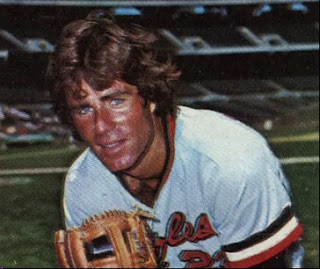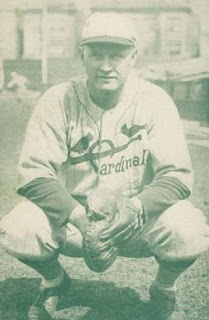Pitcher, Baltimore
Orioles
Age: 30
11th
season with Orioles
Bats – Right,
Throws – Right
Height: 6’3” Weight: 190
Prior to 1976:
A native of New
York City, Palmer was adopted and originally named James Alvin Wiesen. Upon his
father’s death the family moved to California and he was adopted by his
mother’s second husband, whose last name was Palmer. Now Jim Palmer, he played
Little League, Pony League, and Babe Ruth League baseball as a youth. The
family relocated to Scottsdale, Arizona where Palmer attended high school and
played football and basketball as well as baseball, where he pitched and appeared
in center field. While playing summer ball in South Dakota following his high
school graduation, Palmer drew the interest of the Orioles, who signed him to a
$50,000 contract. He had already suffered a knee injury in a car accident that
required surgery. Assigned to Aberdeen of the Class A Northern League in 1964,
Palmer started 19 games and posted an 11-3 record with a 2.51 ERA and 107
strikeouts, although he had problems with his control, as he issued 130 walks
over 129 innings. But still he pitched a no-hitter and, after a winter stint in
the Florida Instructional League, Palmer advanced to the Orioles in 1965.
Utilized as a reliever and spot starter, he appeared in 27 games (6 of them
starts) and went 5-4 with a 3.72 ERA and 75 strikeouts over 92 innings, while
walking 56 batters. Palmer moved into the starting rotation in 1966 and
contributed a 15-10 record to Baltimore’s pennant-winning season, along with a
3.46 ERA and 147 strikeouts. He also acquired the nickname “Cakes” as the
result of his habit of eating pancakes on the mornings of his starts. The
Orioles swept the Dodgers in the World Series and the 20-year-old out-dueled
LA’s star LHP Sandy Koufax in Game 2 for a complete game shutout. Palmer
started the 1967 season well at 2-1, including a one-hit shutout of the
Yankees, until arm trouble reduced his effectiveness and resulted in his being
sent down to the minors for most of the season, returning to the Orioles in
September. He finished with a 3-1 major league tally and a 2.94 ERA over 49
innings. With continued arm soreness, Palmer spent all of 1968 in the minors,
appearing with three different teams with poor results. The Orioles expected
him to pitch through the pain and during a winter stint in Puerto Rico the
soreness disappeared. He regained his spot in the Baltimore rotation in 1969
and was 16-4, despite missing time due to a back injury, with a 2.34 ERA and a
no-hitter against Oakland. In the first year of divisional play in major league
baseball, the Orioles topped the new AL East and Palmer beat the Minnesota Twins
in the third, and final, game of the ALCS. In the World Series he lost his only
start against the New York Mets, who upset Baltimore in five games. The Orioles
had three 20-game winners in 1970, with Palmer (20-10) joining lefthanders Mike
Cuellar (24-8) and Dave McNally (24-9) as Baltimore again finished first in the
AL East. Palmer also led the AL with 305 innings pitched. He and the team had
better luck in the postseason, again sweeping the Twins as Palmer again won the
deciding contest, and this time the Orioles won the World Series against
Cincinnati, and Palmer won the opener and was pulled from Game 4 with a lead
that reliever Eddie Watt couldn’t hold, which led to the only win for the Reds.
The Orioles had an unprecedented four 20-game winners in 1971 on the way to a
third straight AL pennant. Newly-acquired RHP Pat Dobson (20-8) joined Palmer
(20-9), Cuellar (20-9), and McNally (21-5). Palmer battled shoulder stiffness
along the way to 20 complete games and 282 innings pitched with a 2.68 ERA and 184
strikeouts. He was 2-0 in the postseason that resulted in a World Series loss
to Pittsburgh. The Orioles dropped to third place in 1972, but Palmer had a
third consecutive All-Star season on his way to a 21-10 record with a 2.07 ERA
and 184 strikeouts. With an outstanding high fastball as his best pitch, Palmer
also had command of a slow curve and slider. He also had an occasionally
tempestuous relationship with manager Earl Weaver, who appreciated his
righthanded ace’s talent if not always his baseball opinions. Baltimore
returned to the top of the AL East in 1973 and Palmer contributed a 22-9 record
with a league-leading 2.40 ERA and 158 strikeouts and received his first AL Cy
Young Award. He pitched a five-hit shutout against Oakland in the ALCS, which
the A’s ultimately won. Following four consecutive 20-win seasons capped by a
Cy Young Award-winning effort in 1973, Palmer had an off-year in 1974 while
hindered by arm soreness. His record dropped to 7-12 although his ERA was still
respectable at 3.27. He returned to form in 1975 by posting a 23-11 mark with a
league-leading 2.09 ERA and 10 shutouts among his 25 complete games. He
received his second AL Cy Young Award as a result.
1976 Season Summary
Appeared in 40
games
[Bracketed
numbers indicate AL rank in Top 20]
Pitching
Games – 40
Games Started –
40 [1]
Complete Games
– 23 [2, tied with Frank Tanana]
Wins – 22 [1]
Losses – 13
[15, tied with Vida Blue, Eduardo Rodriguez & Mike Cuellar]
PCT - .629 [11]
Saves – 0
Shutouts – 6 [2,
tied with Vida Blue & Bert Blyleven]
Innings Pitched
– 315 [1]
Hits – 255 [7]
Runs – 101 [15,
tied with Ed Figueroa]
Earned Runs – 88
[17, tied with Rick Wise]
Home Runs – 20
[5, tied with Jim Colborn & Ferguson Jenkins]
Bases on Balls
– 84 [9]
Strikeouts – 159
[7]
ERA – 2.51 [5]
Hit Batters – 8
[7, tied with Bill Travers, Jim Hughes & Jim Willoughby]
Balks – 0
Wild Pitches – 5
League-leading games
started were +1 ahead of runners-up Nolan Ryan & Mike Torrez
League-leading
wins were +1 ahead of runner-up Luis Tiant
League-leading
innings pitched were +16.2 ahead of runner-up Jim Hunter
Midseason
Snapshot: 11-8, ERA - 3.00, SO - 88 in 174 IP
---
Most
strikeouts, game – 11 (in 9 IP) at Texas 6/19
10+ strikeout
games – 2
Fewest hits
allowed, game (min. 7 IP) – 1 (in 9 IP) vs. Minnesota 8/10
Fielding
Chances – 77
Put Outs – 27
Assists – 49
Errors – 1
DP – 2
Pct. - .987
Awards & Honors:
AL Cy Young
Award: BBWAA
AL Pitcher of
the Year: Sporting News
Gold Glove
10th
in AL MVP voting (47 points, 14% share)
AL Cy Young
voting (Top 5):
Jim Palmer,
Balt.: 108 points – 19 of 24 first place votes, 90% share
Mark Fidrych,
Det.: 51 points – 5 first place votes, 43% share
Frank Tanana,
Cal.: 18 points – 15% share
Ed Figueroa,
NYY.: 12 points – 10% share
Luis Tiant, Bos.:
10 points – 8% share
---
Orioles went 88-74
to finish second in the AL Eastern Division, 10.5 games behind the
division-winning New York Yankees. Starting off slowly, the Orioles were 40-42
in the season’s first half. A second-half surge capped by a 20-13 record after
September 1 was not enough to contend but allowed for a second-place finish.
Aftermath of ‘76:
Palmer was the Cy Young runner-up in 1977 when he went 20-11 with a 2.91 ERA and 22 complete games and 319 innings pitched, which were both AL-leading figures. Palmer topped the American League in innings pitched for the third straight year with 296 in 1978, on his way to a 21-12 record with a 2.46 ERA. Twice on the disabled list with a sore arm in 1979, he finished at 10-6 with a 3.30 ERA as the Orioles topped the AL East for the first time since 1974. He was 0-1 in the postseason which ended in a World Series loss to Pittsburgh. Palmer had a solid 1980 season, compiling a 16-10 record with a 3.98 ERA. He dipped to a 7-8 tally in strike-interrupted 1981. Following a slow start in 1982, Palmer was briefly exiled to the bullpen but recovered to end up at 15-5 with a 3.13 ERA. He went 5-4 in an injury-plagued 1983 season which concluded with a World Series win in a relief appearance which gave him World Series wins in three different decades. Still, the end was near as Palmer was released by the Orioles during the 1984 season following an 0-3 start. For his major league career, spent entirely with the Orioles, Palmer produced a 268-152 record that included eight 20-win seasons and two ERA titles. His ERA was 2.86 and he compiled 211 complete games that included 53 shutouts. He also struck out 2212 batters over the course of 3948 innings. In addition to three Cy Young Awards, he was a six-time All-Star who received four Gold Gloves for his fielding prowess as well. Pitching in 17 postseason games, he was 8-3 with a 2.61 ERA and 90 strikeouts. Palmer attempted a comeback with Baltimore in 1991 that ended during spring training. Following his playing career, the intelligent and articulate Palmer went into broadcasting, which he had first involved himself with while still a player, as well as being a model in underwear ads. The Orioles retired his #22 and he was inducted into the Baseball Hall of Fame in 1990.
---
Cy Young Profiles feature pitchers who were recipients of
the Cy Young Award by the Baseball Writers’ Association of America (1956 to
present). The award was presented to a single major league winner from its
inception through 1966 and from 1967 on to one recipient from each major
league.





